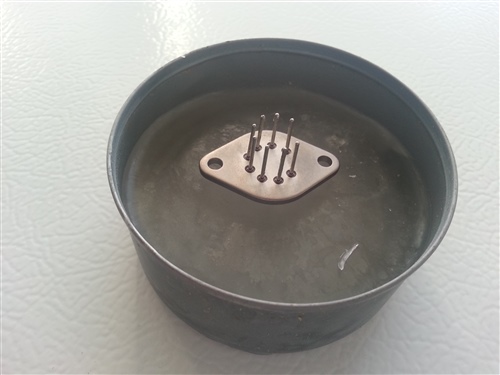Warning: This construction article uses dihydrogen monoxide. Make sure you have researched and understood the dangers associated with this substance before proceeding.
When your home’s deep freezer, full of food, experiences an AC power failure while you are out for an extended time, its contents can thaw out. If the AC power is then restored before you return home, the contents can re-freeze and you may never know that your food is spoiled. This has given rise over the years to a number of freezer-alarm circuits and methods to detect thaw and re-freeze.
In this post, I’ll show you how to build a freezer alarm using a power operational amplifier (op amp). As an added benefit, it has zero power consumption – so you’ll have no worries about losing power or dead batteries. Figure 1 depicts the complete schematic of the freezer alarm.
Figure 1: Complete schematic of the freezer alarm; the OPA2541 actually has two of these circuits
TI has an excellent line of linear power op amps capable of delivering currents up to 10A, or that work on voltages up to 100V, with a wide range of features. For this application, what we need in particular is the metal case TO-3 hermetic OPA2541.
The first crucial step is selecting the housing. For this example, a cleaned, empty can of pet food made an ideal housing.
1. Fill the housing approximately two-thirds full with di-hydrogen monoxide (Figure 2).
Figure 2: To construct the circuit board, fill the housing approximately two-thirds full of dihydrogen monoxide
2. Place the housing in the freezer until the dihydrogen monoxide has fully solidified.
3. Set the power op amp on top of the solidified dihydrogen monoxide (Figure 3).
Figure 3: Simply set the power op amp on top of the hardened dihydrogen monoxide to make the freezer alarm
4. Place the alarm in the freezer.
Set the alarm in a convenient place that’s visible every time you open the freezer. As long as you can see the power op amp, the food is safe to eat (Figure 4). If the power op amp is not on top and has become frozen into the dihydrogen monoxide (Figure 5), you have had a power loss and re-freeze and should discard the food in your freezer.
Figure 4: Typical placement of freezer alarm in freezer, and what you will see as long as everything is OK
Figure 5: If you see this, your freezer has lost and regained power, thawing and then re-freezing its contents; you should discard the food inside. Even when you see that amplifier partly submerged, it would be a good practice to consider discarding the food.
Power can be lost for a host of reasons ranging from technical problems to natural disasters. Here we have shown the "power" of TI op amps. When you are truly looking for a high power linear solution, check out the line of TI power op amps.
Does this solve your freezer problem? Post your feedback in the comments below.
Happy April Fools' Day!
For more from Jerry and his colleagues:
Learn how to design with precision op amps and data converters twice a week on the Precision Hub blog.
Read about analog signal chain tips and technologies on Analog Wire.
See op amps in action in reference designs in the TI Designs library.
Search TI’s entire op amp portfolio, most of which are much newer than the OPA2541. To limit your search to power op amps, use the set the output current column of the parametric table to a minimum current of >200mA.





-

Ian Williams
-
Cancel
-
Up
0
Down
-
-
Reply
-
More
-
Cancel
Comment-

Ian Williams
-
Cancel
-
Up
0
Down
-
-
Reply
-
More
-
Cancel
Children